Aguja Formation
The Aguja Formation is a geological formation in North America, exposed in Texas, United States and Chihuahua and Coahuila in Mexico, whose strata date back to the Late Cretaceous. Dinosaur remains are among the fossils that have been recovered from the formation.[1]
| Aguja Formation Stratigraphic range: Lower to Middle Campanian ~81.5–76.9 Ma | |
|---|---|
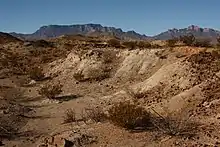 Outcrops of the Aguja Formation, Big Bend National Park, Texas | |
| Type | Geological formation |
| Unit of | Tornillo Group |
| Sub-units | Upper Shale, Terlingua Creek Sandstone, Rattlesnake Mt. Sandstone, Lower Shale & Basal Sandstone Members |
| Underlies | Javelina Formation |
| Overlies | Pen Formation |
| Lithology | |
| Primary | Sandstone, conglomerate, claystone |
| Other | Mudstone, shale, limestone |
| Location | |
| Coordinates | 29.3°N 103.5°W |
| Approximate paleocoordinates | 35.8°N 77.0°W |
| Region | |
| Country | |
 Aguja Formation (the United States)  Aguja Formation (Texas) | |

Age
The ages of the Aguja Formation and its primary fossil-bearing unit, the Upper Shale, are not well understood. Due to the presence of the ammonite Baculites mclearni, which only occurs from 80.67 - 80.21 Ma, in the underlying Rattlesnake Mountain Sandstone and the Terlingua Creek Sandstone, it is likely that the Upper Shale was younger than 80.2 Ma.[2] A radiometric date of 76.9 Ma was recovered in the Upper Shale, making it likely the formation wasn't younger than 76.9 Ma.[2] The contact with the overlying Javelina Formation has been estimated at about 70 Ma ago[3] but also as recently as 68.5 million years ago.[4] This is unlikely, however, due to the presence of Bravoceratops, more primitive than an unnamed chasmosaurine from the De-na-zin Member of the Kirtland Formation, in the lowermost section of the formation.[5] The age of the Basal Sandstone is constrained by the presence of Scaphites hippocrepis III in the overlying Pen Formation which has been dated as old as 81.53 Ma.[2][6]
Vertebrate paleofauna
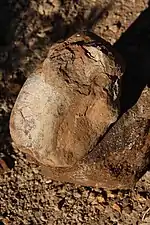
Crurotarsans
| Crurotarsans of the Aguja Formation | ||||||
|---|---|---|---|---|---|---|
| Genus | Species | Location | Member | Material | Notes | Images |
| Deinosuchus[7] | D. riograndensis[7] | Texas,[7] Chihuahua, and Coahuila[8] | osteoderm and mandible fragment |  | ||
| Phobosuchus[7] | P. riograndensis[7] | Texas,[7] Chihuahua, and Coahuila | Reclassified as a Deinosuchus species | |||
Ornithischians
| Ornithischians of the Aguja Formation | ||||||
|---|---|---|---|---|---|---|
| Genus | Species | Location | Member | Material | Notes | Images |
| Agujaceratops[9] | A. mariscalensis[9] | Texas[9] | Low Upper Shale[10] | The type species, A. mariscalensis, was formerly considered a species of Chasmosaurus[9] | 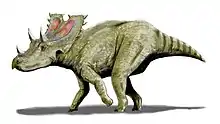 | |
| A. mavericus[11] | Texas | |||||
| Angulomastacator[12] | A. daviesi[12] | Texas[12] | ||||
| Chasmosaurus[13] | C. mariscalensis[14] | Texas[14] | [Twelve] disarticulated skull (sic), postcrania, juvenile."[15] | Considered by paleontologists Lucas, Sullivan, and Hunt to be distinct enough from the Chasmosaurus type species, C. belli to warrant being split off to a new genus, Agujaceratops.[9] | ||
| Edmontonia[14] | E. sp[16][17] | Texas[14][17] |  | |||
| cf. Euoplocephalus[14] | E. sp[14][17] | Texas[14][17] |  | |||
| Panoplosaurus[18] | P. mirus[17] | Texas[17] | ||||
| Aquilarhinus[19] | A. palimentus | Texas[14] | Formerly referred to Kritosaurus and Gryposaurus.[20] | |||
| Kritosaurus[13] | Indeterminate[13] | Chihuahua[21] |  | |||
| Texacephale[22] | T. langstoni[22] | Texas[22] | Low Upper Shale[10] | |||
| Yehuecauhceratops[23] | Y. mudei[24] | Coahuila[25] | 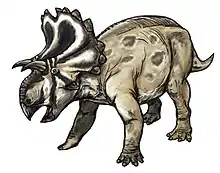 | |||
Saurischians
Indeterminate ornithomimid remains are known from the Upper Aguja Formation.[26] Indeterminate tyrannosaurid fossils are known from the Upper Aguja Formation of Texas and Mexico.[27]
| Saurischians of the Aguja Formation | ||||||
|---|---|---|---|---|---|---|
| Genus | Species | Location | Member | Material | Notes | Images |
| cf. Tyrannosauridae[27] | Indeterminate[27] | Texas[27] | ||||
| cf. Dromaeosaurus[28] | Indeterminate[28] | Texas[14] |  | |||
| Leptorhynchos | L. gaddisi | Texas[29] | A caenagnathid |  | ||
| Ricardoestesia[30] | R. cf. gilmorei[31] | Texas[30] | ||||
| R. isosceles[30] | Texas[30] | |||||
| Saurornitholestes[14] | S. cf. langstoni[32] | Texas[14] |  | |||
| cf. Troodon[33] | Indeterminate[33] | Texas[14] | .jpg.webp) | |||
Turtles
| Testudines of the Aguja Formation | ||||||
|---|---|---|---|---|---|---|
| Genus | Species | Location | Member | Material | Notes | |
| Terlinguachelys[7] | T. fischbecki[7] | Texas | Rattlesnake Mountain Sandstone[7] | |||
Ammonites
| Ammonites of the Aguja Formation | ||||||
|---|---|---|---|---|---|---|
| Genus | Species | Location | Member | Abundance | Notes | Images |
| Baculites | B. mclearni |
|
||||
| Hoplitoplacenticeras | H. plasticum | Rattlesnake Mountain Sandstone | ||||
| Pachydiscus | P. paulsoni | Rattlesnake Mountain Sandstone | 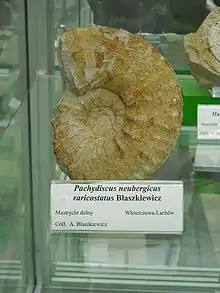 | |||
Color key
|
Notes Uncertain or tentative taxa are in small text; |
See also
- List of dinosaur-bearing rock formations
References
- Weishampel et al., 2004, "Dinosaur distribution (Late Cretaceous, North America).", pp.574-588
- Fowler, Denver Warwick (2017-11-22). "Revised geochronology, correlation, and dinosaur stratigraphic ranges of the Santonian-Maastrichtian (Late Cretaceous) formations of the Western Interior of North America". PLOS ONE. 12 (11): e0188426. Bibcode:2017PLoSO..1288426F. doi:10.1371/journal.pone.0188426. ISSN 1932-6203. PMC 5699823. PMID 29166406.
- Woodward, H. N. (2005). Bone histology of the sauropod dinosaur Alamosaurus sanjuanensis from the Javelina Formation, Big Bend National Park, Texas.
- Sankey, J. (2010). Faunal composition and significance of high–diversity, mixed bonebeds containing Agujaceratops mariscalensis and other dinosaurs, Aguja Formation (Upper Cretaceous), Big Bend, Texas. In New Perspectives on Horned Dinosaurs: The Royal Tyrrell Museum Ceratopsian Symposium (pp. 520-537).
- Fowler, Denver W.; Fowler, Elizabeth A. Freedman (2020-06-05). "Transitional evolutionary forms in chasmosaurine ceratopsid dinosaurs: evidence from the Campanian of New Mexico". PeerJ. 8: e9251. doi:10.7717/peerj.9251. ISSN 2167-8359. PMC 7278894. PMID 32547873.
- Prieto-Márquez, Albert; Wagner, Jonathan R.; Lehman, Thomas (2020-03-18). "An unusual 'shovel-billed' dinosaur with trophic specializations from the early Campanian of Trans-Pecos Texas, and the ancestral hadrosaurian crest" (PDF). Journal of Systematic Palaeontology. 18 (6): 461–498. doi:10.1080/14772019.2019.1625078. ISSN 1477-2019. S2CID 202018197.
- "Aguja Formation (Upper Shale Member), Big Bend Region, Texas," in Sullivan and Lucas (2006). Page 16.
- "The first mandible fragment of Deinosuchus (Eusuchia: Alligatoroidea) discovered in Coahuila, Mexico". ResearchGate. Retrieved 2016-03-27.
- "Abstract," Lucas, Sullivan, and Hunt (2006)
- Longrich, N. R.; Sankey, J.; Tanke, D. (2010). "Texacephale langstoni, a new genus of pachycephalosaurid (Dinosauria: Ornithischia) from the upper Campanian Aguja Formation, southern Texas, USA". Cretaceous Research. 31 (2): 274. doi:10.1016/j.cretres.2009.12.002.
- Lehman, T.M.; Wick, S.L.; Barnes, K.R. (2016). "New specimens of horned dinosaurs from the Aguja Formation of West Texas, and a revision of Agujaceratops". Journal of Systematic Palaeontology. Online edition. doi:10.1080/14772019.2016.1210683.
- Wagner and Lehman (2009).
- "Dinosaur distribution (Texas and Chihuahua)." Weishampel, et al. (2004). Page 582 and 588.
- "Dinosaur distribution (Late Cretaceous; North America; Texas)." Weishampel, et al. (2004). Page 582.
- "Table 23.1," in Weishampel, et al. (2004). Page 496.
- Listed as Edmontonia cf. rugosidens in "Dinosaur distribution (Late Cretaceous; North America; Texas).", Weishampel et al., 2004, p.582
- West, Bryanna (2020). Campanian-Maastrictian Ankylosaurs of West Texas (PDF) (Thesis). Texas Tech University.
- West, Bryanna (2020). Campanian-Maastrictian Ankylosaurs of West Texas (PDF) (Thesis). Texas Tech University.
- Listed as ?Gryposaurus sp. in "Dinosaur distribution (Late Cretaceous; North America; Texas)." Weishampel, et al. (2004). Page 582.
- Prieto-Márquez, A. (2013). "Skeletal morphology of Kritosaurus navajovius (Dinosauria:Hadrosauridae) from the Late Cretaceous of the North American south-west, with an evaluation of the phylogenetic systematics and biogeography of Kritosaurini." Journal of Systematic Palaeontology, (advance online publication) doi:10.1080/14772019.2013.770417
- "Dinosaur distribution (Late Cretaceous; North America; Chihuahua)." Weishampel, et al. (2004). Page 588.
- "Abstract," Longrich, Sankey, and Tanke (2010).
- Rivera-Sylva, H.E.; Hendrick, B.P.; Dodson, P. (2016). "A Centrosaurine (Dinosauria: Ceratopsia) from the Aguja Formation (Late Campanian) of Northern Coahuila, Mexico". PLOS ONE. 11 (4): e0150529. Bibcode:2016PLoSO..1150529R. doi:10.1371/journal.pone.0150529. PMC 4830452. PMID 27073969.
- Rivera-Sylva, H.E.; Hendrick, B.P.; Dodson, P. (2016). "A Centrosaurine (Dinosauria: Ceratopsia) from the Aguja Formation (Late Campanian) of Northern Coahuila, Mexico". PLOS ONE. 11 (4): e0150529. Bibcode:2016PLoSO..1150529R. doi:10.1371/journal.pone.0150529. PMC 4830452. PMID 27073969.
- Rivera-Sylva, H.E.; Frey, E.; Stinnesbeck, W.; Guzman-Gutirrez, J.R.; Gonzalez-Gonzalez (2017). "Mexican ceratopsids: Considerations on their diversity and evolution". Journal of South American Earth Sciences. doi:10.1016/j.jsames.2017.01.008.
- Sullivan, R.M., and Lucas, S.G. 2006. "The Kirtlandian land-vertebrate "age" – faunal composition, temporal position and biostratigraphic correlation in the nonmarine Upper Cretaceous of western North America." New Mexico Museum of Natural History and Science, Bulletin 35:7-29.
- Mortimer, M (2004). "Tyrannosauroidea". The Theropod Database. Archived from the original on 2013-09-29. Retrieved 2007-08-21.
- Listed as cf. Dromaeosaurus sp. in "Dinosaur distribution (Late Cretaceous; North America; Texas)." Weishampel, et al. (2004). Page 582.
- Longrich, N. R.; Barnes, K.; Clark, S.; Millar, L. (2013). "Caenagnathidae from the Upper Campanian Aguja Formation of West Texas, and a Revision of the Caenagnathinae". Bulletin of the Peabody Museum of Natural History 54: 23. doi:10.3374/014.054.0102. edit
- "Dinosaur distribution (Late Cretaceous; North America; Texas)." Weishampel, et al. (2004). Page 581.
- Listed as R. cf. gilmorei in "Dinosaur distribution (Late Cretaceous; North America; Texas)." Weishampel, et al. (2004). Page 581.
- Listed as Saurornitholestes cf. langstoni in "Dinosaur distribution (Late Cretaceous; North America; Texas)." Weishampel, et al. (2004). Page 582.
- Listed as cf. Troodon sp. in "Dinosaur distribution (Late Cretaceous; North America; Texas)." Weishampel, et al. (2004). Page 582.
Bibliography
- Lehman, Thomas M.; Susan L. Tomlinson (2004). "Terlinguachelys fischbecki, a new genus and species of sea turtle (Chelonioidea: Protostegidae) from the Upper Cretaceous of Texas". Journal of Paleontology. The Paleontological Society. 78 (6): 1163–1178. doi:10.1666/0022-3360(2004)078<1163:TFANGA>2.0.CO;2.
- Longrich, N.R., Sankey, J., and Tanke, D. (2010) Texacephale langstoni, a new genus of pachycephalosaurid (Dinosauria: Ornithischia) from the upper Campanian Aguja Formation, southern Texas, USA. Cretaceous Research. doi:10.1016/j.cretres.2009.12.002.
- Sullivan, R.M., and Lucas, S.G. 2006. "The Kirtlandian land-vertebrate "age" – faunal composition, temporal position and biostratigraphic correlation in the nonmarine Upper Cretaceous of western North America." New Mexico Museum of Natural History and Science, Bulletin 35:7-29.
- Spencer G. Lucas, Robert M. Sullivan and Adrian P. Hunt: Re-evaluation of Pentaceratops and Chasmosaurus (Ornithischia: Ceratopsidae) in the Upper Cretaceous of the Western Interior. In: New Mexico Museum of Natural History and Science Bulletin 35 (2006), S. 367-370.PDF
- Wagner, Jonathan R.; Lehman, Thomas M. (2009). "An Enigmatic New Lambeosaurine Hadrosaur (Reptilia: Dinosauria) from the Upper Shale Member of the Campanian Aguja Formation of Trans-Pecos Texas". Journal of Vertebrate Paleontology. 29 (2): 605–611. doi:10.1671/039.029.0208. S2CID 128555861.
- Weishampel, David B.; Peter Dodson, and Halszka Osmólska (eds.). 2004. The Dinosauria, 2nd edition, 1–880. Berkeley: University of California Press. Accessed 2019-02-21. ISBN 0-520-24209-2